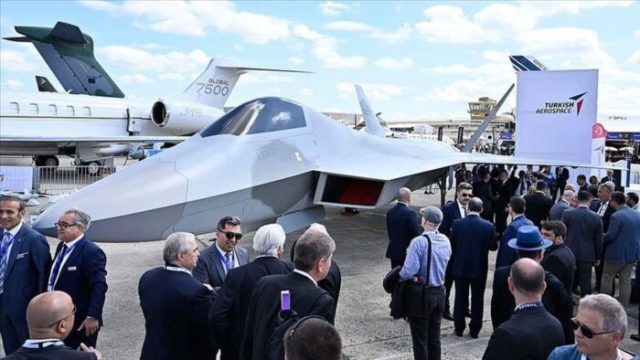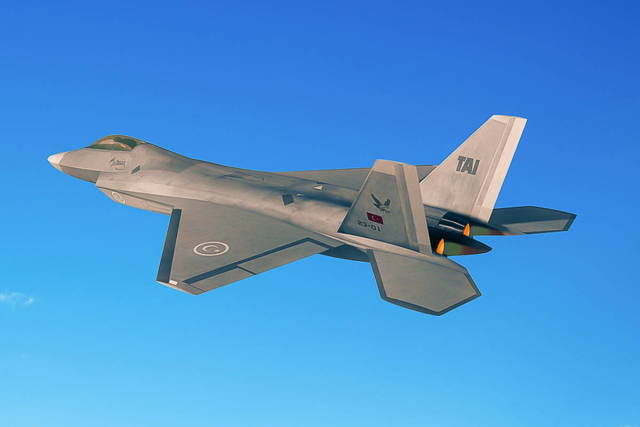The 5th Generation Experimental Turkish Fighter (TF-X, Turkish Fighter-Experimental) is a single–seat twin-engined all-weather multi-purpose combat aircraft designed to gain air superiority. The general contractor of the project is the Turkish Aerospace Company (Turkish Aerospace Industries, TAI), technological support is provided by the British BAE Systems. Currently, in TAI, this program is called shorter: Turkish Fighter (TF), – excluding the letter "X" and, thereby, emphasizing that the development is no longer experimental.
The draft part of the TF-X project was completed in December 2017, and the full-size model of the fighter was first presented to the general public on June 17, 2019 during the Paris Air Show (PAS 2019). According to Turkish sources, its manufacture took place in Germany and cost the customer $ 2.25 million. The next demonstration of the new generation national combat aircraft (Turkish abbreviation MMU) took place in September of the same year at the Technofest festival in Istanbul.

Full-size TF-X mock-up at the Paris Air Show
The MMU/TF-X program has acquired special significance for Ankara after the US government suspended deliveries of 5th generation F-35A aircraft to the Turkish Air Force. According to open sources, today the Turkish Air Force has about 30 F-4E aircraft and 238 F-16C /D fighters, which form the basis of the country's combat aviation. The first ones were planned to be replaced by an American car and decommissioned in 2020. Now, with a high probability, their write-off should be expected no earlier than 2025. The situation is similar with the F-16C/D: the beginning of their decommissioning to replace the F-35A was scheduled for 2030. In general, it was planned to purchase up to 110 F-35A. According to experts, after the termination of US-Turkish cooperation on the subject of the 5th generation aircraft, the order volume of the MMU/TF-X fighter for the Turkish Air Force will be from 150 to 200 machines, which in the long term will replace the outdated F-4E and F-16C/D.
According to TAI, in aerial combat, the MMU/TF-X fighter will be able to hit the enemy with a new weapon of increased range, used at supersonic speed, with the "support of artificial intelligence and neural networks." It is planned that the aircraft will have low radar and IR visibility, a high degree of situational awareness, better maneuverability (than the F-16), advanced high-precision weapons systems that exchange data between sensors and a fire control system.
The model must maintain a stable supersonic cruising speed (super cruise mode), optimize the load on the pilot and assess the degree of combat damage. The ability to interact with other aircraft, including 5th generation fighters and unmanned aerial vehicles, will make the Turkish development suitable for modern joint operations. In addition, the machine must be stable, easy to maintain, provide quick preparation for departure, guarantee profitability throughout the entire life cycle.
The general tactical and technical characteristics of the promising fighter Turkish Aerospace initially presented in the specifications in December 2017. They were officially unveiled at the Paris Air Show in June 2019. Later, in December 2019, during the conference "Turkish Defense Industry – MMU/TF-X Dialogues", the updated data were provided by the Deputy Director General of TAI, responsible for the MMU/TF-X program, Professor Mustafa CAVCAR. Based on these sources, it is obvious that the fighter will receive the following TTX: length in the range of 19-21 m (60 ft), height 6 m, wingspan from 12 to 14 m (46 ft), wing area from 60 to 70 sq.m. (750 sq.m.ft), maximum take-off weight (MTOW) of more than 27,215 kg (60,000 lb).
It is planned to install two turbojet dual-circuit engines (turbojet engines) of local production with a thrust of 12200 kgf (27,000 pounds) on the aircraft. The prototypes will be equipped with a pair of engines of the F100 family with a thrust of 13400 kgf (29,500 pounds) each. The TF-X should have a maximum speed of Mach 1.8-2, a practical ceiling of 16700 m (55,000 ft) and a combat radius of about 1,100 km (600 nautical miles).
Assessing the presented characteristics, experts note that the MMU/TF-X is larger in size than existing 5th generation fighters, including the American F-22 Raptor and F-35 Lightning II , the Chinese J-20A/B Mighty Dragon and the South Korean KF-X. Nevertheless, the overall design of the Turkish layout resembles the design of the American Raptor. Similar features include: fixed inlet pipes of air intakes, air pressure relief doors in the rear fuselage, thrust vector control and inclined vertical tail.
Variants of aircraft weapons for MMU/TF-X
Like the F-22 Raptor, the Turkish MMU/TF-X has internal compartments for weapons. The ventral weapons compartment will be able to accommodate up to four medium- and long-range (BVR) air-to-air missiles, as well as ammunition and air-to-ground missiles with a caliber from 110 to 900 kg (250 to 2,000 pounds). Each side compartment, to the left and right of the fuselage, will be able to accommodate two short-range air-to-air missiles (WVR). Presenting a mock-up of a fighter jet at the Paris Air Show, the President and CEO of Turkish Aerospace Temel KOTIL mentioned the METEOR long-range missiles of the European concern MBDA and some promising weapons of Turkish manufacturers as an example of a possible weapon for the TF-X.
The advanced avionics kit of the aircraft will include:A radar with an AFAR of its own design made of gallium nitride (GaN), an integrated computing complex (mission computer), an infrared search and tracking system (IRST, installed in front of the cockpit), an electronic warfare kit and an electro-optical guidance system (EOTS, in Turkish BEOS, with functionality similar to the F-35 fighter).
The intelligent cockpit is planned to be equipped with several panoramic displays with a graphical interface, environmental data systems, digital maps, as well as high-tech communication devices and a sight system on the pilot's helmet (HMDS). The cabin's functionality also includes voice recognition and voice control, high-quality audio systems and synthetic vision.
Continued:
TF-X is a Turkish fighter of the 5th generation. Part II
Based on the materials of the Defense Turkey magazine

